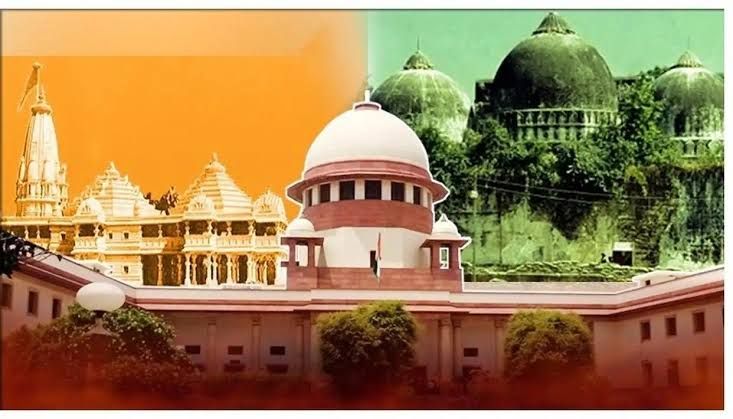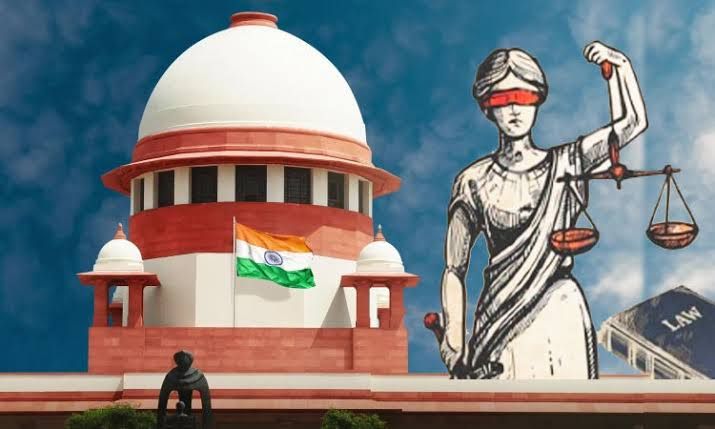Author:Vidhyanand Roy
Student at: Sri Krishna Jubilee Law College, Muzaffarpur,Bihar
TO THE POINT
A religion provides a set of belief which further give a purpose in life. In moment’s artificial period there’s an emergence in the conception of determination. Secularism is a conception where an reality is religion neutral. In our Indian constitution religious freedom is a fundamental right, every person has its own right to profess any religion they like.
India has espoused the principle of secularism in the constitution in order to save, cover and maintain the culture and traditions of all the persuasions. Notwithstanding, varying mindsets and different beliefs of people leads to discord in the society which further leads to violence and disturbance, some controversies are veritably prolonged which bear trial of the court of law. One similar disagreement arose in the case of M Siddiq (D) Thr Lrs v. Mahant Suresh Das & Ors, popularly known as Ayodhya agreement case.
LEGAL JAGRON
Secularism: The term secularism means ever citizens has a right to profess and practice the religion of their own choice
Equity: The term equity means fairness and justice.
ABSTRACT
This article examines how equity of religion is applied in the case of Ayodhya disagreement. This Article also contains a brief history regarding the origin of the disagreement. Further it discusses the brief facts and judgement pronounced by the honourable apex court. It also deals with the conception of secularism and how it relates to Ayodhya disagreement. This case endured over for nearly 134 years and everything began with 1500 square yard plot of land which is situated in Fariabad in the state of Uttar Pradesh. The most interesting fact of the case is that not only the individuals even the divine beings struggled over the contested land to guarantee their legitimate proprietorship.
FACT OF THE CASE
This is the story of an Ayodhya mega city which cohabits both, Hindus and Muslims. The first religious violence in Ayodhya took place in the time of 1850 over a near synagogue at Hanuman Garhi. In this process, the Babri Mosque was attacked by Hindus. Original Hindus always demand sometimes for the possession of the land where Babri Mashjid was constructed and they should be allowed to make a tabernacle on that land. They believed that the Babri synagogue was erected by breaking a Hindu Temple. But, their demand was always refused by the social government. On 2nd December 1949, an offshoot Hindu Mahasabha called Akhil Bharatiya Ramayana Mahasabha organized 9 days nonstop enumeration of Ramcharitmanas, at the end of which Hindus activist broke into synagogue and established icons of Rama and Sita outside. Jawaharlal Nehru ordered to remove icons but the same was refused by a original functionary K.K.K. Nair claiming it would lead to collaborative screams. The police locked the gates and entry was banned for both Hindus as well as Muslim.preachers were allowed to enter for diurnal deification as icons were present outside and Masjid had been converted into a de facto tabernacle. Both Sunni Waqf Board and AMRM filed a civil suit in original court claiming their religious rights on point.
The legal battle over the Ayodhya began in 1950 when a solicitation was first filed by Gopal Singh Visharad. Who was refused entry. He was Ayodhya clerk of the Hindu Mahasabha, an association formed to oppose the temporal principle of the Congress party. The court dragged on the issue for nearly a decade and in 1959 the Nirmokhi Akhara filed another complaint complaining that the area should be in their possession. In response to the below-mentioned suits, the Sunni Central Waqf Council filed a counter-request in 1961. The Council was established by Indian law to cover and save Muslim religious and artistic spots.
Issues Raised
The issue of this case revolved around the possession of land traditionally regarded as the motherland of Lord Ram and the history of Babri mosque.
One of the major issues of this case was-
Whether a former Hindu tabernacle was demolished or modified to construct a synagogue by Babur?
Written Submission of parties to the case
After the long hail of 14 days, the supreme court has given 3 days to all parties of this case to give written submission and clear what are they actually soliciting. Following are the summary of written statements by different parties to this case-
Nirmohi Akhara
In the event that the verdict comes in favour of one of the Hindu parties Akhara should retain the right to service the deity.
The authorization to make a Ram tabernacle on the disputed point and Akhara should be authorised to manage the demesne once the tabernacle is erected.
Still, the court should ask the Muslim parties to give their share of the land to the Hindu parties, if the court decides to confirm the verdict of the High Court of Allahabad in 2010 and the Muslim parties declare that they won’t do any construction on the disputed point. On a long term parcel so that a large Ram taberlance can be ereted. (the verdict of the High Court of Allahabad had divided the disputed land into three corridor the Sunni Waqf Council, the Nirmokhi Akhara and Ram Lalla), The court should order the government to giveland to the Muslim side to make a synagogue outside the conflict area.
Ram Lalla Virajman
The written submission on behalf of Ram Lalla Virajman says that the court should give all of the lands in disagreement to Ram Lalla. The statement stated that no part of the disputed ;and should be given to the Nirmokhi Akhara of the Muslim parties.
Ram Janambhoomi Punar Sudhar Samiti
Gopal Singh Visharad, whose ancestors would have performed rituals on the tabernacle point for centuries, argued that it’s his indigenous right to offer prayers to Ram Janmabhoomi.
His statement said that there should be no concession in the Ram Janambhoomi case.
Sunni Waqf Board
The commission has stated that it wishes to gain the same remedy as that invoked at the sounds. During the sounds, commission counsel, Rajeev Dhawan, requested that the Babri Masjid recapture its form before being destroyed on December 6, 1992.
Hindu Mahasabha
The Supreme court is anticipated to form a trust to oversee the operation of the Ram tabernacle to be erected on the disputed point in Ayodhya.
The apex court should appoint an director to deal with the trust.
Shia Wafq Board
During their relief casting before the High Court of Allahabad, they said that the Muslim parties should give up their claim on the disputed land and hand it over to the Hindu parties to make a Ram tabernacle. In a written submission, the Shia Waqf board of directors said that a Ram tabernacle should be erected on the disputed point in Ayodhya. He stated that the Waqf Shiite council is the legal proprietor of the disputed land, not the Waqf Sunni Council. The land that was given to Sunni Waqf Council in the High Court order should now be given to Hindu parties.
JUDGEMENT
The bench of five judges of the apex court heard the action cases on the title from August to October 2019. on 9th November 2019, the apex court led by the Chief Justice Ranjan Gogoi, blazoned its verdict; he quashed the former ruling and ruled that the land belonged to the government on the base of the duty records. He further ordered that the land to be turned over to a trust for the construction of the Hindu tabernacle, he ordered the government to contribute another five acre piece of land to the Waqf Sunni Council to make the synagogue.
Following are the top ten points stressed in the judgement of the case-
The apex court granted the entire 2.77 acres of disputed land in Ayodhya to the deity Ram Lalla.
The apex court ordered the government of central and uttar pradesh to allocate 5-acre indispensable land to Muslims in a prominent position to make a synagogue.
The court asked the centre to consider giving some kind of representation to Nirmokhi Akhara for setting up a trust, Nirmokhi Akhara was the third party to the Ayodhya conflict.
The apex court rejected the plea of Nirmokhi Akhara, who sought to control all of the disputed lands, claiming that it was custodian. The apex court ordered the union government to produce a trust in 3 months for the construction of the Ram Mandir on the disputed point of the Babri Masjid was demolished in 1992.
The apex court said that the structured below the disputed point in Ayodhya wasn’t an Islamic structure but the Assistant Sub-Inspector (ASI) didn’t establish whether a tabernacle was demolished to make a synagogue.
The court also declared that the Hindus regard the disputed point as the motherland of Lord Ram while Muslim also say the same thing about the point of Babri Masjid.
The court also declared that the Hindu’s belief that Lord Rama was born on the disputed point where Babri Masjid was formerly cannot be challenged.
The apex court also declared that the 1992 obliteration of the 16th century Babri Masjid synagogue was a violation of the law.
While reading its judgement the apex court declared that the UP’s Waqf Central Sunni Council hadn’t established that they were in possession of the external yard of the point in disagreement. A brief timeline from the circumstance of the disagreement to the end of the disagreement
On 6th December 1992- The Babri synagogue was demolished by a gathering of nearly 200,000 Karsevaka. Community screams across India followed.
On 16th December 1992- Ten days after the obliteration the Congressional government at the centre, led by PV Narasimha Rao, set up a commission of inquiry under the leadership of Judge Liberhan. 6th August 2019- The 5 Judge indigenous bench, headed by Chief Justice Ranjan Gogoi, of the apex court, began the final hail on the case.
On 16th October 2019- The final hail before the apex court ends. The bench reserved the final judgement. The court gave the parties to the conflict three days to file written notes on the “shaping of the remedy” or on the issues on which the court must decide.
On 9th November 2019- Final judgement rendered. The apex court ordered the retention of the land to a trust for the construction of the Temple of Ram. It also ordered the government to contribute 5 acres of land within the mega city limits of Ayodhya to the Sunni Waqf Council to make a synagogue.
On 12th December 2019- All desires for review of the verdict dismissed by the apex court.
CONCLUSION
This case is important because this is a dragged case in the history of the India Judiciary and witnessed all the Prime Ministers of India, from Jawaharlal Nehru to Narendra Modi. Eventually, this disagreement was resolved on 9th November 2019. in this judgement the apex court tried to approach this case in a harmonious way and tried to abolish a balance between both the religion. The apex court granted the entire 2.77 acres of disputed land in Ayodhya to the deity Ram Lalla. The apex court ordered the government of central and Uttar Pradesh to allocate 5 acre indispensable land to Muslims in a prominent position to make a synagogue.
FAQ
What was the total area of land given for construction of Ram Mandir?
2.77 acres of land is given for Ram Mandir.
2) How many years it took for dispute settlement on Ram Mandir?
It took more than 130 years to settle the Ayodhya dispute.
REFERENCES
https://m.economictimes.com
https://www.thehindu.com
www.scobserver.in





